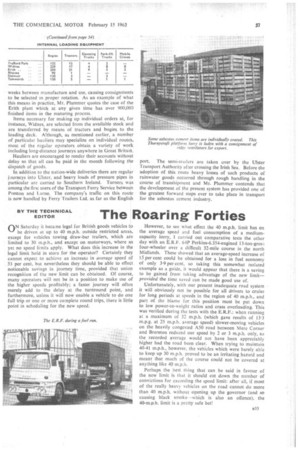The Roaring Forties
Page 59

If you've noticed an error in this article please click here to report it so we can fix it.
nN Saturday it became legal for British goods vehicles to be driven at up to 40 m.p.h. outside restricted areas, except for vehicles towing draw-bar trailers, which are limited to 30 m.p.h., and except on motorways, where as yet no speed limits apply. What does this increase in the legal limit hold in store for the operator? Certainly they cannot expect to achieve an increase in average speed of 33 per cent, but nevertheless they should be able to effect noticeable savings in journey time, provided that union recognition of the new limit can be obtained. Of course, many operators will not be in a position to make use of the higher speeds profitably; a faster journey will often merely add to the delay at the turriround point, and furthermore, unless it will now enable a vehicle to do one full trip or one or more complete round trips, there is little point in scheduling for the new speed. However, to see what effect the 40 m.p.h. limit has on the average speed and fuel consumption of a mediumcapacity lorry, I carried out comparative tests the other day with an E.R.F. 64P Perkins-6.354-engined 13-ton-gros3 four-wheeler over a difficult 32-mile course in the north Midlands. These showed that an average-speed increase of 15 per cent could be obtained for a loss in fuel economy of only 3-9 percent, so taking this somewhat isolated example as a guide, it would appear that there is a saving to be gained from taking advantage of the new limit— provided the time saved can be made good use of.
Unfortunately, with our present inadequate road system it will obviously not be possible for all drivers to cruise for long periods at speeds in the region of 40 m.p.h., and part of the blame for this position must be put down to low power-to-weight ratios and crass overloading. This was verified during the tests with the E.R.F.: when running at a maximum of 32 m.p.h. (which gave results of 13-3 m.p.g. at 25 m.p.h. average speed) slower-moving vehicles on the heavily congested A50 road between Mere Corner and Brereton reduced our speed by 2 or 3 m.p.h. only, so the recorded average would not have been appreciably higher had the road been clear. When trying to maintain 40-41 m.p.h., however, the vehicles which were barely able to keep up 30 m.p.h. proved to be an irritating hazard and meant that much of the course could not be covered at anything like 40 m.p.h.
Perhaps the best thing that can be said in favour of the new limit is that it should cut down the number of convictions for exceeding the speed limit: after all, if most of the really heavy vehicles on the road cannot do more than 40 m.p.h. without opening up the governor (and so causing black smoke—which is also an offence), the 40-m.p.h. limit is a pretty safe bet!












































































































